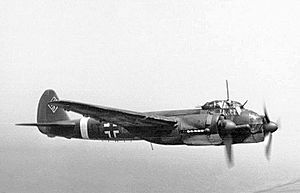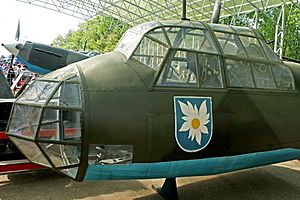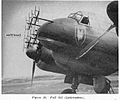Junkers Ju 88 facts for kids
Quick facts for kids Ju 88 |
|
|---|---|
 |
|
| A Ju 88A over France in 1942. | |
| Role | |
| Manufacturer | Junkers |
| Designer | Ernst Zindel, W. H. Evers, and Alfred Gassner |
| First flight | 21 December 1936 |
| Introduction | 1939 |
| Retired | 1951 (France) |
| Primary user | Luftwaffe |
| Number built | 15,183 |
| Variants | Junkers Ju 188 |
The Junkers Ju 88 was a famous World War II airplane from Nazi Germany. It was a twin-engined aircraft used by the Luftwaffe, Germany's air force. The company Junkers Flugzeug- und Motorenwerke (JFM) designed it in the mid-1930s. They wanted a Schnellbomber, which means a "fast bomber." The idea was that it would fly so fast that enemy fighter planes couldn't catch it.
Even though it had some technical problems early on, the Ju 88 became one of the most useful planes of the war. It could do many jobs. It served as a bomber, a dive bomber (which drops bombs while diving), a night fighter, a torpedo bomber (which attacks ships with torpedoes), and a reconnaissance aircraft (for spying). It was also used as a heavy fighter. Towards the end of the war, some were even turned into flying bombs.
The Ju 88 was very important to the Luftwaffe. It was built non-stop from 1936 to 1945. More than 16,000 Ju 88s were made in many different versions. This was more than any other twin-engine German aircraft from that time. The basic design of the plane stayed mostly the same throughout its production.
It was used in major battles like the Battle of France and the Battle of Britain.
Contents
Designing the Ju 88 Aircraft
In August 1935, the German Ministry of Aviation asked for a new type of plane. They wanted an unarmed, three-seat bomber that could fly very fast. It also needed to carry a bomb load of about 800 to 1,000 kilograms (1,760 to 2,200 pounds).
Junkers started designing the Ju 88 based on these needs. They also worked on a similar design called the Ju 85. The Ju 85 was a twin-engine bomber prototype. It was different from the Ju 88 because it had two tail fins. However, the Ju 85 was never used in service.
The very first Ju 88, called the Ju 88 V1 prototype, flew on December 21, 1936. It had the civil registration D-AQEN. When it first flew, it reached a speed of about 580 kilometers per hour (360 miles per hour). Hermann Göring, who was the head of the Luftwaffe, was very excited. He believed this plane could finally deliver on the promise of a "high-speed bomber."
Building the Ju 88: Production Challenges
Even though the Ju 88 was designed early, its production faced many delays. It had a lot of problems during its development. The plane was supposed to be ready for service in 1938. However, it only began to be used by squadrons (with just 12 planes) on the first day of the invasion of Poland in 1939.
Building the planes was very slow. Only one Ju 88 was made each week because new problems kept appearing. A version of the Ju 88 called the Ju 88C, which was a heavy fighter, was also designed early in 1940. But this was kept a secret from Göring. He only wanted bombers at that time.
Images for kids
-
Three Ju 88s flying over Astypalaia, Greece, in 1943.
-
The cockpit cover of a Ju 88, kept at the Finnish Aviation Museum in Vantaa.
-
A Ju-88D (tropicalized version) at the National Museum of the United States Air Force.
See also
 In Spanish: Junkers Ju 88 para niños
In Spanish: Junkers Ju 88 para niños





















